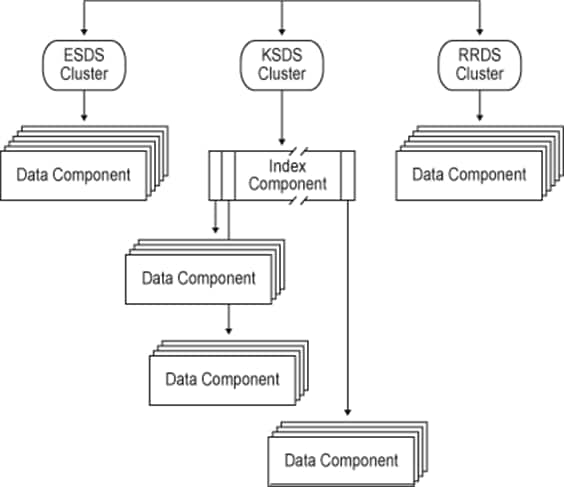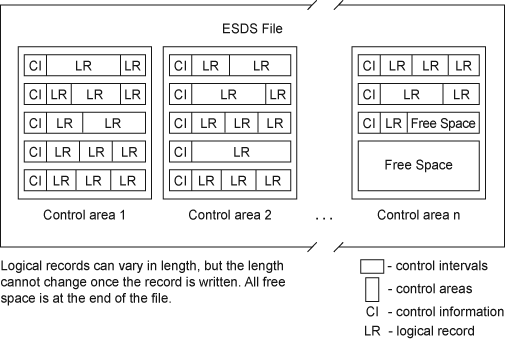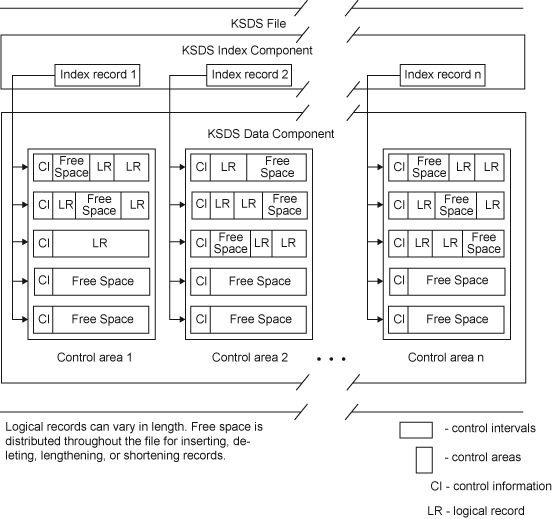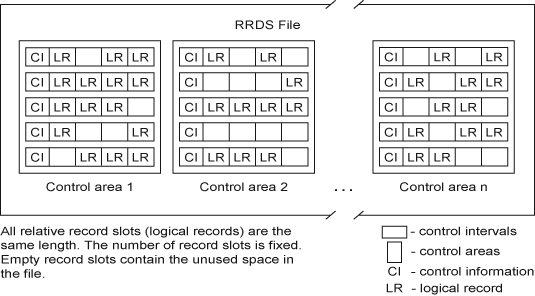What is Virtual Storage Access Method (VSAM)?
Introduction to VSAM
VSAM is
an IBM data access method that enables you to organize and access records in a disk data set.
VSAM is available under the z/OS operating environment. There are
three types of data set organization:
SAS supports all of
these VSAM features, although not necessarily in all possible combinations.
By specifying options in the INFILE statement in your SAS program,
you can read, update, create, and erase records from VSAM data sets. See Supported VSAM Operations and Access Types for a summary
of the operations that SAS supports.
Access Methods
Access methods are software
routines that control the data transfer between primary storage (main
memory) and secondary storage devices. Secondary, or auxiliary, storage
is independent of the computer's memory (for example, storage on tape
or disk). VSAM is designed specifically for use with disks. Because
VSAM data set structure permits the use of both direct and sequential
access types, you can select either the type or the combination of
access types that best suits your specific application requirements.
Direct
access means that you have the ability to read any data
record in a data set directly, without reading preceding records in
the data set. For more information, see Direct Access. (The terms direct and random are sometimes used interchangeably when referring
to data organization, access methods, and storage devices. SAS documentation
uses the term direct, but you might find
that random is used in other literature.)
Sequential
access means that you retrieve a series of records in
sequence. Sequence has a different meaning for each of the three VSAM
data set organizations. For more information, see Sequential Access.
Skip sequential
access means that you use a combination of both direct
and sequential access. For more information, see Skip Sequential Access.
Access Methods and File Organization
Data stored on IBM disks can be organized in a number of ways, which
are referred to as data set types. IBM software supports the following
data set types:
In each data set type
except VSAM, the records are organized in a unique way, depending
on their purpose. Each type of data set organization has one or more
special access methods. (For example, a data set that uses DA organization
is characterized by a predictable relationship between the key of
a record and the address of that record on a DASD device.) The programmer
establishes this relationship and must supply most of the logic required
to locate the individual records.
VSAM is a multifunction, all-purpose
access method. VSAM is different from the other data set types because
it provides a functional equivalent for most of the other data set
organizations, as follows:
Types of VSAM Data Sets
There are three types of VSAM data
sets. The main difference between the three data set types is the
logical order in which data records are arranged in the data set.
The following is a description of each type of VSAM data set:
(Entry-Sequenced Data
Set) The record sequence is determined by the order in which the records
are entered into the data set, without respect to the record contents.
New records are stored at the end of the data set.
(Key-Sequenced Data
Set) The record sequence is determined by a key containing a unique
value, such as an employee, invoice, or transaction number. The key
is a contiguous portion of the record and is defined when the data
set is created. The record order is defined by the EBCDIC collating
sequence of the key field contents.
The figure below, VSAM Data Set Organization: Data Components and Index Components shows how the three types of VSAM
data sets are organized.
When a VSAM data set
is created, it is defined in a cluster.
A cluster encompasses the components of
a VSAM data set. ESDS and RRDS clusters have only a data component.
A KSDS cluster has a data component and an index component. The index
relates each record's key to its location in the data set. VSAM uses
the index to sequence and locate the records of a KSDS.
VSAM Record Structure and Organization
Records in VSAM data sets are grouped into control intervals, the units of data transfer between
main storage and secondary disk storage. Control intervals are continuous areas of direct access storage that VSAM uses for
storing records and to control information describing them. Although
the size of control intervals varies from one data set to another,
the size within a data set is fixed, either by VSAM or by you (within
VSAM imposed restrictions). If VSAM chooses the size, it does so based
on the DASD type, record size, and smallest amount of virtual storage
space that the user applications make available for I/O buffers. A
spanned record is one that exceeds the established control interval
size by spanning one or more control interval boundaries. Spanned
records are permitted in an ESDS and a KSDS, but not in an RRDS.
Control intervals
are grouped into control areas. Control areas are the units of a data
set that VSAM preformats as records are added to the data set. VSAM
fixes the number of control intervals for each control area. (See ESDS Control Intervals and Control Areas, KSDS Control Intervals and Control Areas, and RRDS Control Intervals and Control Areas for depictions
of the control interval formats used by each of the data set types.)
KSDS control areas are used for distributing free space throughout
the data set, as a percentage of control intervals per control area.



